Evaluating Primary Health Care: Social Determinants & Health Impact
VerifiedAdded on 2023/06/14
|10
|2641
|482
Essay
AI Summary
This essay examines a primary health care project through the lens of social determinants of health and key primary health care principles. It analyzes how factors like social support networks and social environment influenced the need for the project, citing the 'It Takes a Village' video as a case study. The essay also discusses how community participation and health promotion guided the project, particularly in initiatives like the 'Young Mum's' and 'Fishing Fathers' programs. Furthermore, it identifies mental health as a National Health Priority Area impacted by the program, highlighting the potential for improving community well-being by addressing parental stress and reducing child abuse. Finally, the essay defines cultural competence and cultural safety, emphasizing their importance in program development and providing examples from the video where these concepts are demonstrated through culturally sensitive support and education.
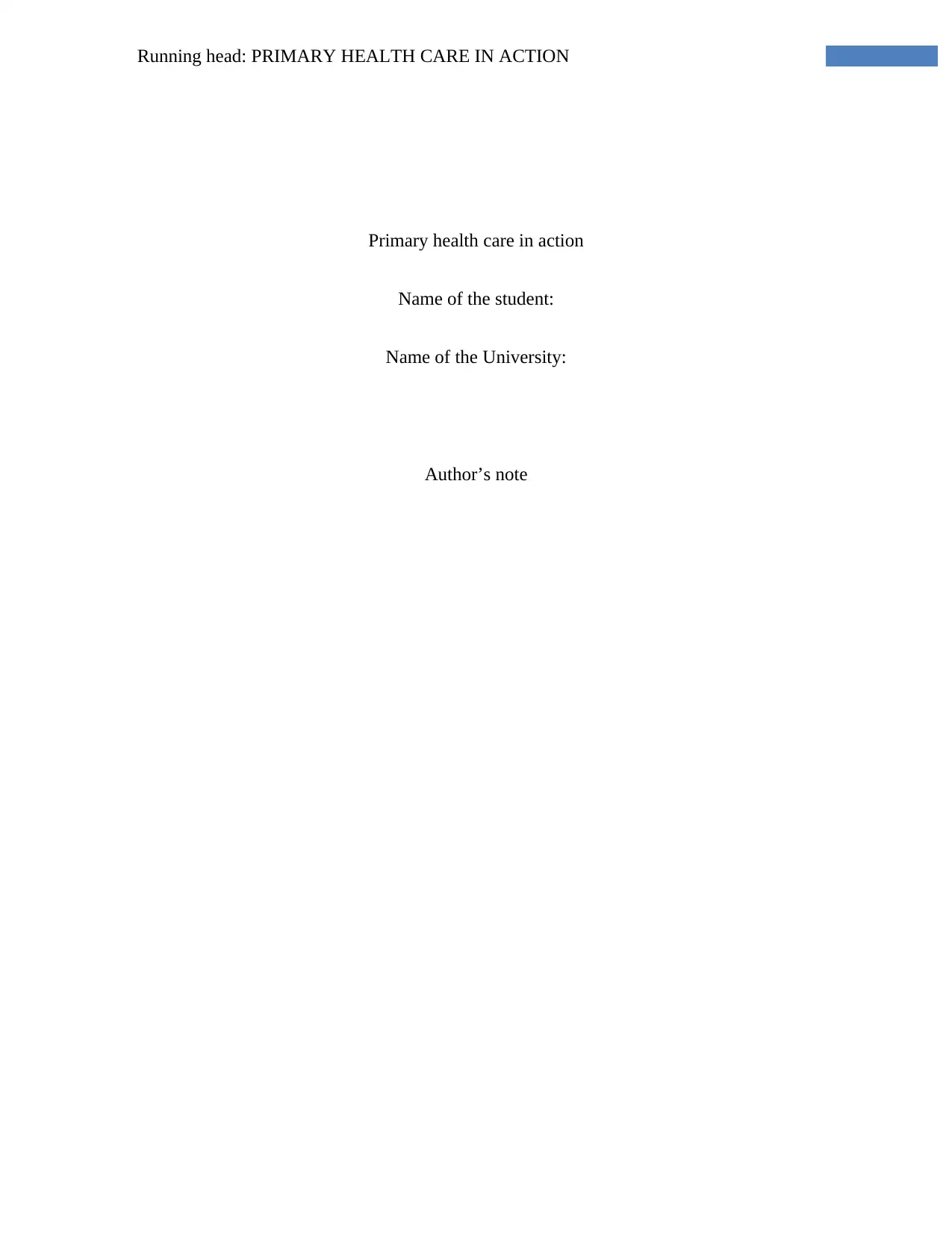
Running head: PRIMARY HEALTH CARE IN ACTION
Primary health care in action
Name of the student:
Name of the University:
Author’s note
Primary health care in action
Name of the student:
Name of the University:
Author’s note
Paraphrase This Document
Need a fresh take? Get an instant paraphrase of this document with our AI Paraphraser
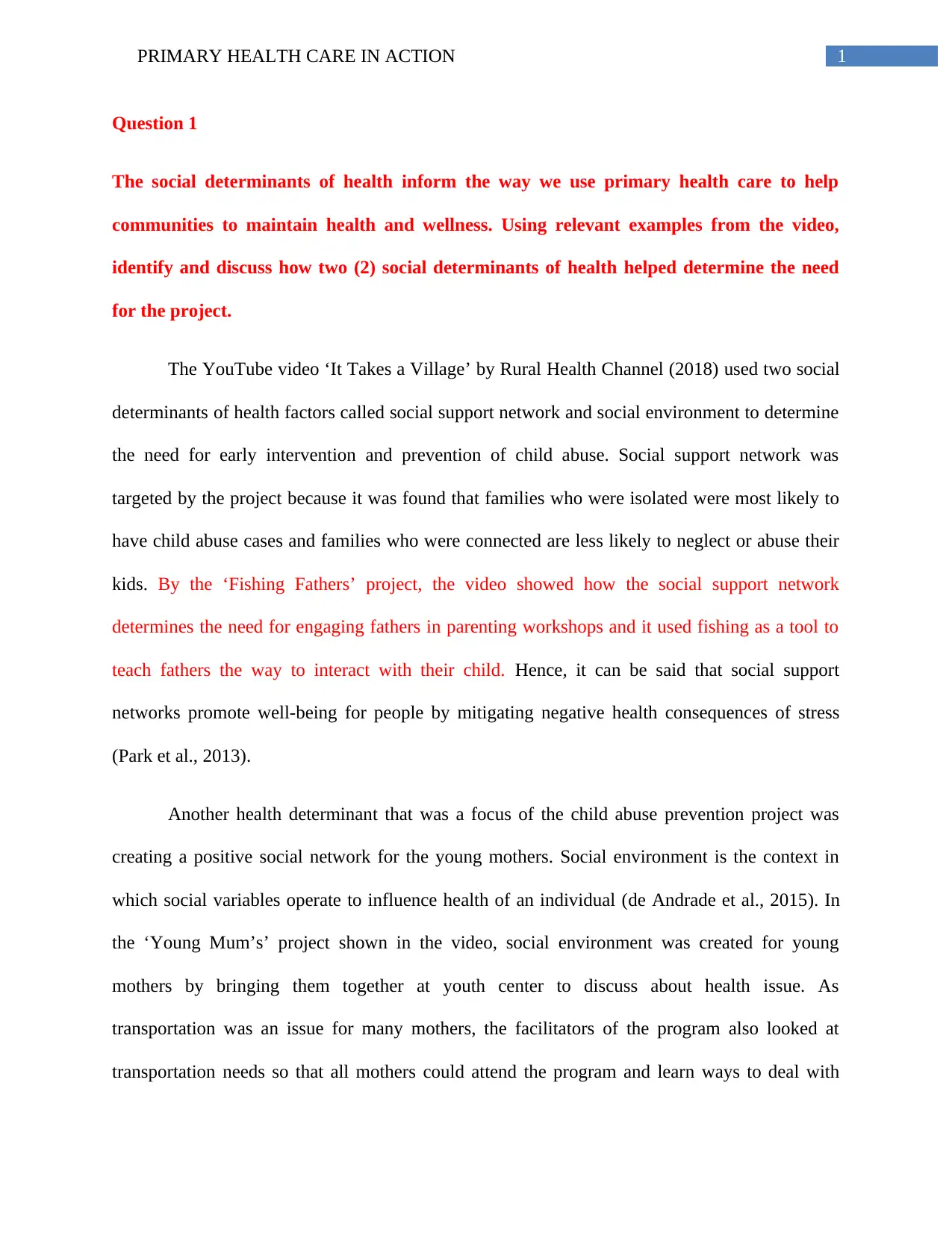
1PRIMARY HEALTH CARE IN ACTION
Question 1
The social determinants of health inform the way we use primary health care to help
communities to maintain health and wellness. Using relevant examples from the video,
identify and discuss how two (2) social determinants of health helped determine the need
for the project.
The YouTube video ‘It Takes a Village’ by Rural Health Channel (2018) used two social
determinants of health factors called social support network and social environment to determine
the need for early intervention and prevention of child abuse. Social support network was
targeted by the project because it was found that families who were isolated were most likely to
have child abuse cases and families who were connected are less likely to neglect or abuse their
kids. By the ‘Fishing Fathers’ project, the video showed how the social support network
determines the need for engaging fathers in parenting workshops and it used fishing as a tool to
teach fathers the way to interact with their child. Hence, it can be said that social support
networks promote well-being for people by mitigating negative health consequences of stress
(Park et al., 2013).
Another health determinant that was a focus of the child abuse prevention project was
creating a positive social network for the young mothers. Social environment is the context in
which social variables operate to influence health of an individual (de Andrade et al., 2015). In
the ‘Young Mum’s’ project shown in the video, social environment was created for young
mothers by bringing them together at youth center to discuss about health issue. As
transportation was an issue for many mothers, the facilitators of the program also looked at
transportation needs so that all mothers could attend the program and learn ways to deal with
Question 1
The social determinants of health inform the way we use primary health care to help
communities to maintain health and wellness. Using relevant examples from the video,
identify and discuss how two (2) social determinants of health helped determine the need
for the project.
The YouTube video ‘It Takes a Village’ by Rural Health Channel (2018) used two social
determinants of health factors called social support network and social environment to determine
the need for early intervention and prevention of child abuse. Social support network was
targeted by the project because it was found that families who were isolated were most likely to
have child abuse cases and families who were connected are less likely to neglect or abuse their
kids. By the ‘Fishing Fathers’ project, the video showed how the social support network
determines the need for engaging fathers in parenting workshops and it used fishing as a tool to
teach fathers the way to interact with their child. Hence, it can be said that social support
networks promote well-being for people by mitigating negative health consequences of stress
(Park et al., 2013).
Another health determinant that was a focus of the child abuse prevention project was
creating a positive social network for the young mothers. Social environment is the context in
which social variables operate to influence health of an individual (de Andrade et al., 2015). In
the ‘Young Mum’s’ project shown in the video, social environment was created for young
mothers by bringing them together at youth center to discuss about health issue. As
transportation was an issue for many mothers, the facilitators of the program also looked at
transportation needs so that all mothers could attend the program and learn ways to deal with
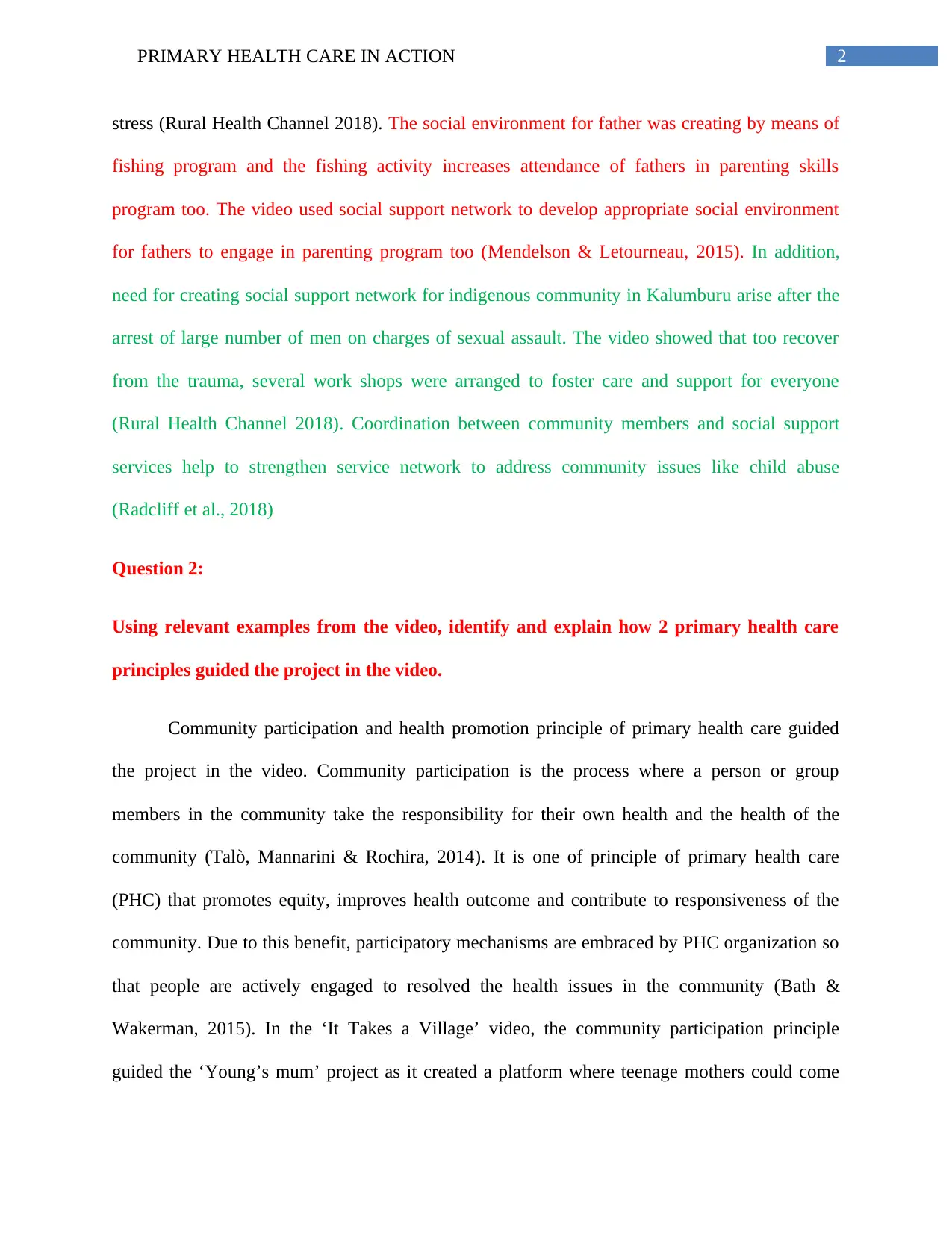
2PRIMARY HEALTH CARE IN ACTION
stress (Rural Health Channel 2018). The social environment for father was creating by means of
fishing program and the fishing activity increases attendance of fathers in parenting skills
program too. The video used social support network to develop appropriate social environment
for fathers to engage in parenting program too (Mendelson & Letourneau, 2015). In addition,
need for creating social support network for indigenous community in Kalumburu arise after the
arrest of large number of men on charges of sexual assault. The video showed that too recover
from the trauma, several work shops were arranged to foster care and support for everyone
(Rural Health Channel 2018). Coordination between community members and social support
services help to strengthen service network to address community issues like child abuse
(Radcliff et al., 2018)
Question 2:
Using relevant examples from the video, identify and explain how 2 primary health care
principles guided the project in the video.
Community participation and health promotion principle of primary health care guided
the project in the video. Community participation is the process where a person or group
members in the community take the responsibility for their own health and the health of the
community (Talò, Mannarini & Rochira, 2014). It is one of principle of primary health care
(PHC) that promotes equity, improves health outcome and contribute to responsiveness of the
community. Due to this benefit, participatory mechanisms are embraced by PHC organization so
that people are actively engaged to resolved the health issues in the community (Bath &
Wakerman, 2015). In the ‘It Takes a Village’ video, the community participation principle
guided the ‘Young’s mum’ project as it created a platform where teenage mothers could come
stress (Rural Health Channel 2018). The social environment for father was creating by means of
fishing program and the fishing activity increases attendance of fathers in parenting skills
program too. The video used social support network to develop appropriate social environment
for fathers to engage in parenting program too (Mendelson & Letourneau, 2015). In addition,
need for creating social support network for indigenous community in Kalumburu arise after the
arrest of large number of men on charges of sexual assault. The video showed that too recover
from the trauma, several work shops were arranged to foster care and support for everyone
(Rural Health Channel 2018). Coordination between community members and social support
services help to strengthen service network to address community issues like child abuse
(Radcliff et al., 2018)
Question 2:
Using relevant examples from the video, identify and explain how 2 primary health care
principles guided the project in the video.
Community participation and health promotion principle of primary health care guided
the project in the video. Community participation is the process where a person or group
members in the community take the responsibility for their own health and the health of the
community (Talò, Mannarini & Rochira, 2014). It is one of principle of primary health care
(PHC) that promotes equity, improves health outcome and contribute to responsiveness of the
community. Due to this benefit, participatory mechanisms are embraced by PHC organization so
that people are actively engaged to resolved the health issues in the community (Bath &
Wakerman, 2015). In the ‘It Takes a Village’ video, the community participation principle
guided the ‘Young’s mum’ project as it created a platform where teenage mothers could come
⊘ This is a preview!⊘
Do you want full access?
Subscribe today to unlock all pages.

Trusted by 1+ million students worldwide
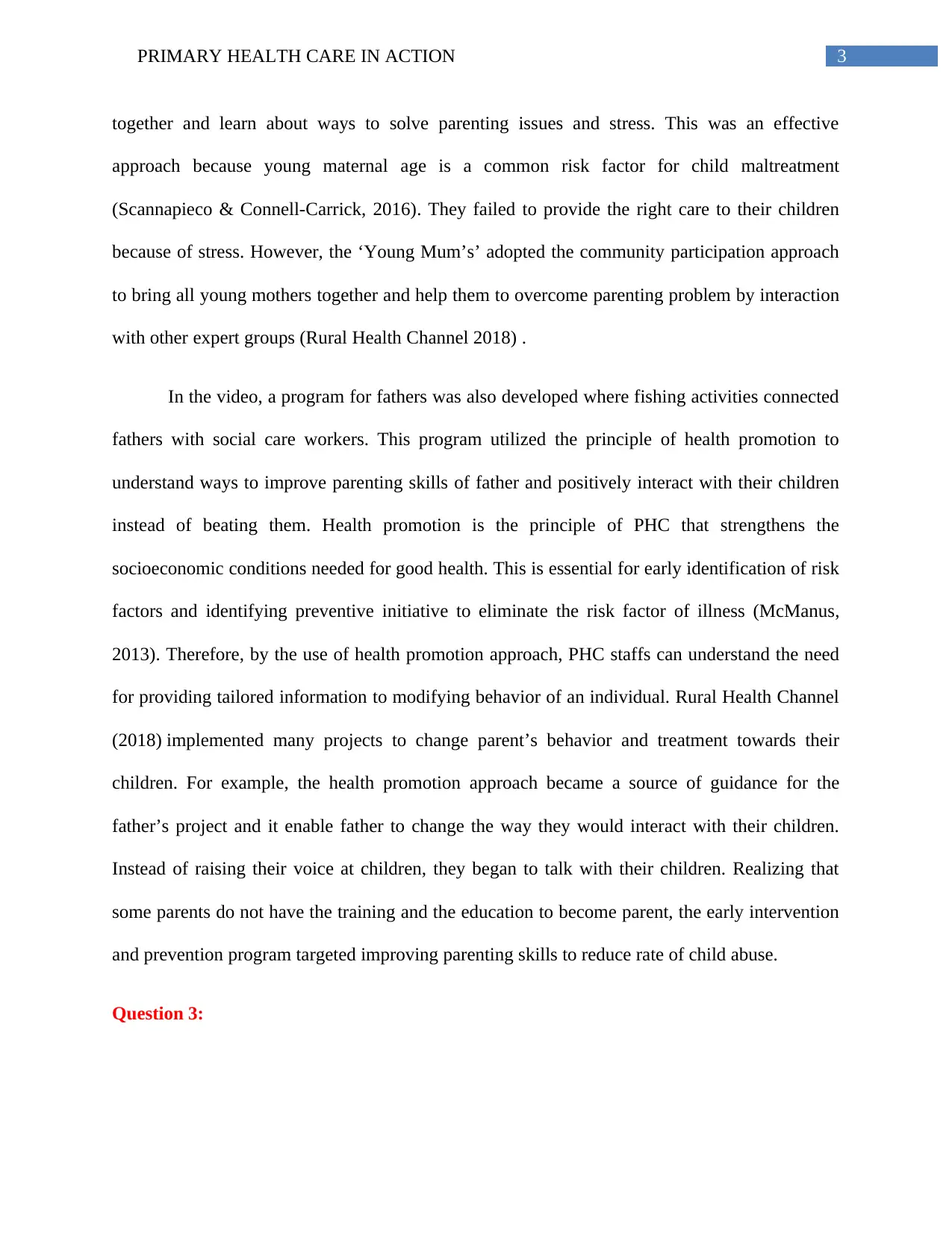
3PRIMARY HEALTH CARE IN ACTION
together and learn about ways to solve parenting issues and stress. This was an effective
approach because young maternal age is a common risk factor for child maltreatment
(Scannapieco & Connell-Carrick, 2016). They failed to provide the right care to their children
because of stress. However, the ‘Young Mum’s’ adopted the community participation approach
to bring all young mothers together and help them to overcome parenting problem by interaction
with other expert groups (Rural Health Channel 2018) .
In the video, a program for fathers was also developed where fishing activities connected
fathers with social care workers. This program utilized the principle of health promotion to
understand ways to improve parenting skills of father and positively interact with their children
instead of beating them. Health promotion is the principle of PHC that strengthens the
socioeconomic conditions needed for good health. This is essential for early identification of risk
factors and identifying preventive initiative to eliminate the risk factor of illness (McManus,
2013). Therefore, by the use of health promotion approach, PHC staffs can understand the need
for providing tailored information to modifying behavior of an individual. Rural Health Channel
(2018) implemented many projects to change parent’s behavior and treatment towards their
children. For example, the health promotion approach became a source of guidance for the
father’s project and it enable father to change the way they would interact with their children.
Instead of raising their voice at children, they began to talk with their children. Realizing that
some parents do not have the training and the education to become parent, the early intervention
and prevention program targeted improving parenting skills to reduce rate of child abuse.
Question 3:
together and learn about ways to solve parenting issues and stress. This was an effective
approach because young maternal age is a common risk factor for child maltreatment
(Scannapieco & Connell-Carrick, 2016). They failed to provide the right care to their children
because of stress. However, the ‘Young Mum’s’ adopted the community participation approach
to bring all young mothers together and help them to overcome parenting problem by interaction
with other expert groups (Rural Health Channel 2018) .
In the video, a program for fathers was also developed where fishing activities connected
fathers with social care workers. This program utilized the principle of health promotion to
understand ways to improve parenting skills of father and positively interact with their children
instead of beating them. Health promotion is the principle of PHC that strengthens the
socioeconomic conditions needed for good health. This is essential for early identification of risk
factors and identifying preventive initiative to eliminate the risk factor of illness (McManus,
2013). Therefore, by the use of health promotion approach, PHC staffs can understand the need
for providing tailored information to modifying behavior of an individual. Rural Health Channel
(2018) implemented many projects to change parent’s behavior and treatment towards their
children. For example, the health promotion approach became a source of guidance for the
father’s project and it enable father to change the way they would interact with their children.
Instead of raising their voice at children, they began to talk with their children. Realizing that
some parents do not have the training and the education to become parent, the early intervention
and prevention program targeted improving parenting skills to reduce rate of child abuse.
Question 3:
Paraphrase This Document
Need a fresh take? Get an instant paraphrase of this document with our AI Paraphraser
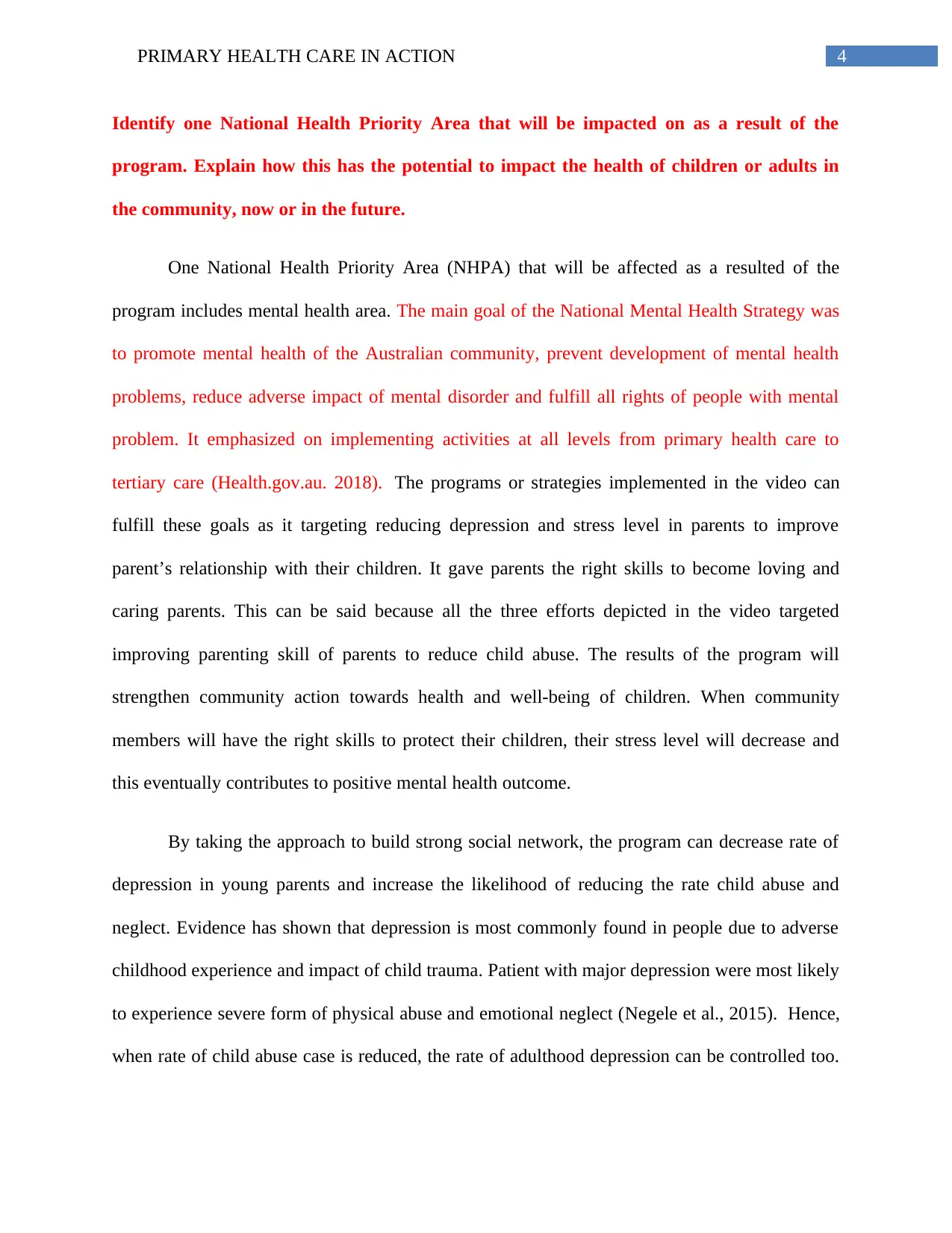
4PRIMARY HEALTH CARE IN ACTION
Identify one National Health Priority Area that will be impacted on as a result of the
program. Explain how this has the potential to impact the health of children or adults in
the community, now or in the future.
One National Health Priority Area (NHPA) that will be affected as a resulted of the
program includes mental health area. The main goal of the National Mental Health Strategy was
to promote mental health of the Australian community, prevent development of mental health
problems, reduce adverse impact of mental disorder and fulfill all rights of people with mental
problem. It emphasized on implementing activities at all levels from primary health care to
tertiary care (Health.gov.au. 2018). The programs or strategies implemented in the video can
fulfill these goals as it targeting reducing depression and stress level in parents to improve
parent’s relationship with their children. It gave parents the right skills to become loving and
caring parents. This can be said because all the three efforts depicted in the video targeted
improving parenting skill of parents to reduce child abuse. The results of the program will
strengthen community action towards health and well-being of children. When community
members will have the right skills to protect their children, their stress level will decrease and
this eventually contributes to positive mental health outcome.
By taking the approach to build strong social network, the program can decrease rate of
depression in young parents and increase the likelihood of reducing the rate child abuse and
neglect. Evidence has shown that depression is most commonly found in people due to adverse
childhood experience and impact of child trauma. Patient with major depression were most likely
to experience severe form of physical abuse and emotional neglect (Negele et al., 2015). Hence,
when rate of child abuse case is reduced, the rate of adulthood depression can be controlled too.
Identify one National Health Priority Area that will be impacted on as a result of the
program. Explain how this has the potential to impact the health of children or adults in
the community, now or in the future.
One National Health Priority Area (NHPA) that will be affected as a resulted of the
program includes mental health area. The main goal of the National Mental Health Strategy was
to promote mental health of the Australian community, prevent development of mental health
problems, reduce adverse impact of mental disorder and fulfill all rights of people with mental
problem. It emphasized on implementing activities at all levels from primary health care to
tertiary care (Health.gov.au. 2018). The programs or strategies implemented in the video can
fulfill these goals as it targeting reducing depression and stress level in parents to improve
parent’s relationship with their children. It gave parents the right skills to become loving and
caring parents. This can be said because all the three efforts depicted in the video targeted
improving parenting skill of parents to reduce child abuse. The results of the program will
strengthen community action towards health and well-being of children. When community
members will have the right skills to protect their children, their stress level will decrease and
this eventually contributes to positive mental health outcome.
By taking the approach to build strong social network, the program can decrease rate of
depression in young parents and increase the likelihood of reducing the rate child abuse and
neglect. Evidence has shown that depression is most commonly found in people due to adverse
childhood experience and impact of child trauma. Patient with major depression were most likely
to experience severe form of physical abuse and emotional neglect (Negele et al., 2015). Hence,
when rate of child abuse case is reduced, the rate of adulthood depression can be controlled too.
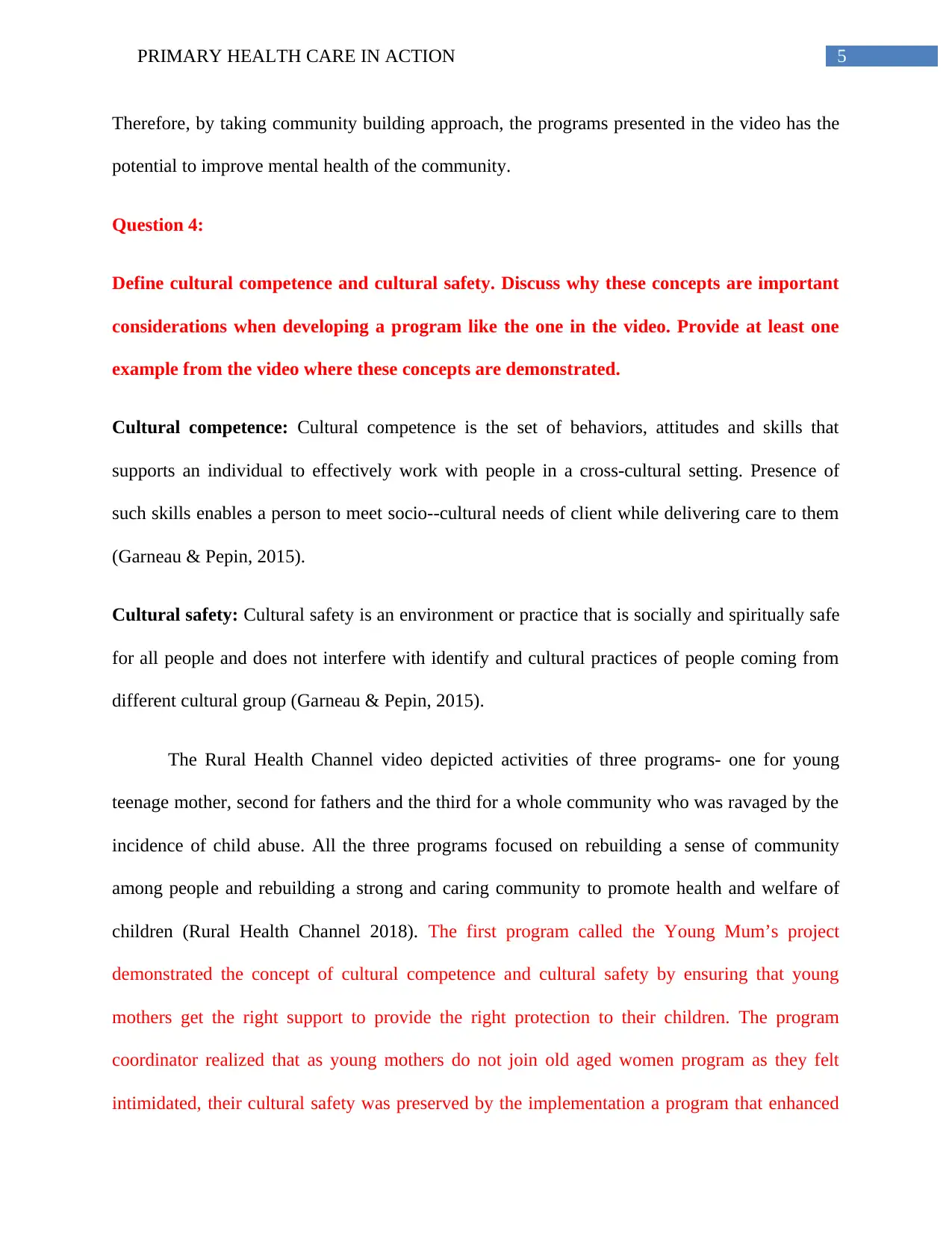
5PRIMARY HEALTH CARE IN ACTION
Therefore, by taking community building approach, the programs presented in the video has the
potential to improve mental health of the community.
Question 4:
Define cultural competence and cultural safety. Discuss why these concepts are important
considerations when developing a program like the one in the video. Provide at least one
example from the video where these concepts are demonstrated.
Cultural competence: Cultural competence is the set of behaviors, attitudes and skills that
supports an individual to effectively work with people in a cross-cultural setting. Presence of
such skills enables a person to meet socio--cultural needs of client while delivering care to them
(Garneau & Pepin, 2015).
Cultural safety: Cultural safety is an environment or practice that is socially and spiritually safe
for all people and does not interfere with identify and cultural practices of people coming from
different cultural group (Garneau & Pepin, 2015).
The Rural Health Channel video depicted activities of three programs- one for young
teenage mother, second for fathers and the third for a whole community who was ravaged by the
incidence of child abuse. All the three programs focused on rebuilding a sense of community
among people and rebuilding a strong and caring community to promote health and welfare of
children (Rural Health Channel 2018). The first program called the Young Mum’s project
demonstrated the concept of cultural competence and cultural safety by ensuring that young
mothers get the right support to provide the right protection to their children. The program
coordinator realized that as young mothers do not join old aged women program as they felt
intimidated, their cultural safety was preserved by the implementation a program that enhanced
Therefore, by taking community building approach, the programs presented in the video has the
potential to improve mental health of the community.
Question 4:
Define cultural competence and cultural safety. Discuss why these concepts are important
considerations when developing a program like the one in the video. Provide at least one
example from the video where these concepts are demonstrated.
Cultural competence: Cultural competence is the set of behaviors, attitudes and skills that
supports an individual to effectively work with people in a cross-cultural setting. Presence of
such skills enables a person to meet socio--cultural needs of client while delivering care to them
(Garneau & Pepin, 2015).
Cultural safety: Cultural safety is an environment or practice that is socially and spiritually safe
for all people and does not interfere with identify and cultural practices of people coming from
different cultural group (Garneau & Pepin, 2015).
The Rural Health Channel video depicted activities of three programs- one for young
teenage mother, second for fathers and the third for a whole community who was ravaged by the
incidence of child abuse. All the three programs focused on rebuilding a sense of community
among people and rebuilding a strong and caring community to promote health and welfare of
children (Rural Health Channel 2018). The first program called the Young Mum’s project
demonstrated the concept of cultural competence and cultural safety by ensuring that young
mothers get the right support to provide the right protection to their children. The program
coordinator realized that as young mothers do not join old aged women program as they felt
intimidated, their cultural safety was preserved by the implementation a program that enhanced
⊘ This is a preview!⊘
Do you want full access?
Subscribe today to unlock all pages.

Trusted by 1+ million students worldwide
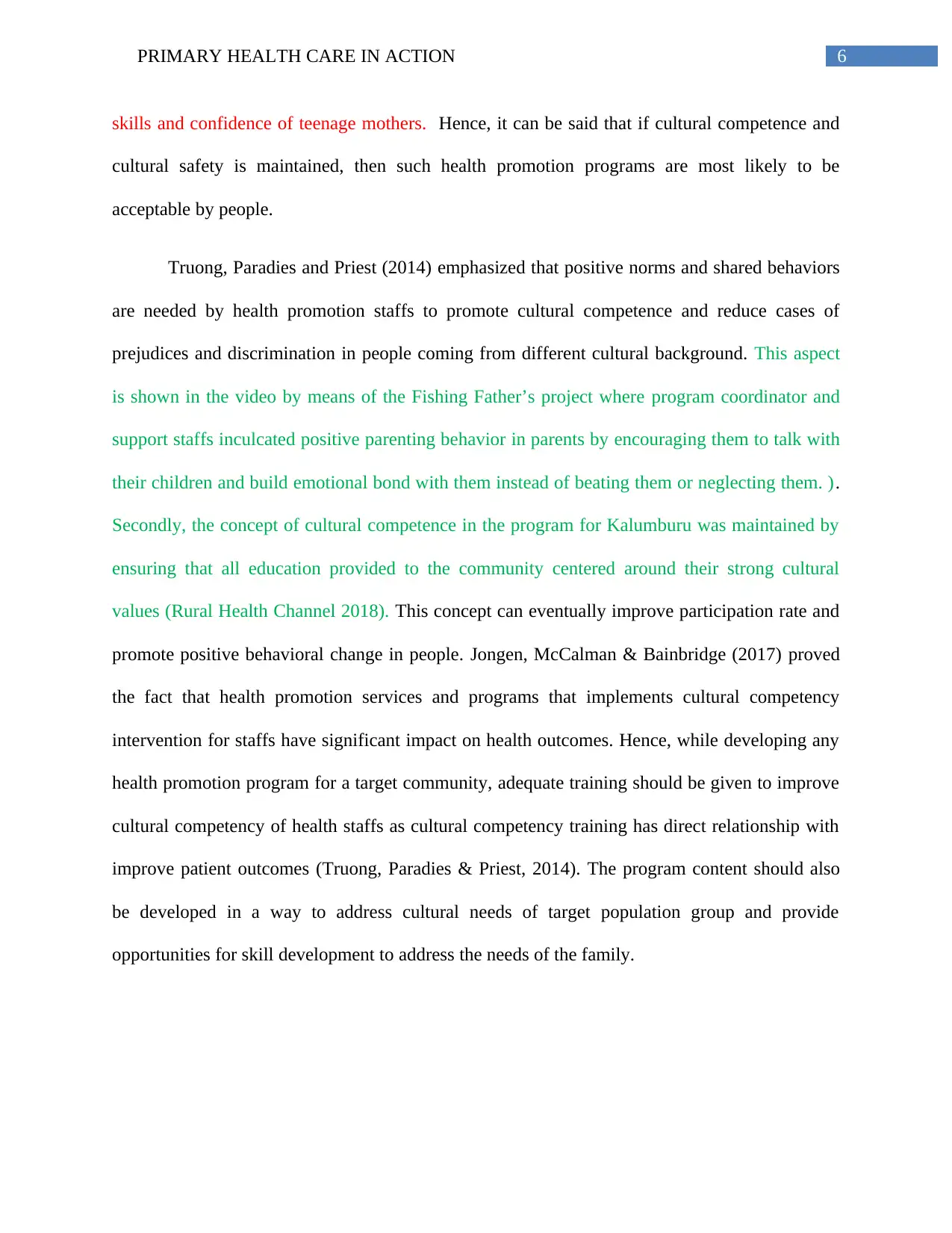
6PRIMARY HEALTH CARE IN ACTION
skills and confidence of teenage mothers. Hence, it can be said that if cultural competence and
cultural safety is maintained, then such health promotion programs are most likely to be
acceptable by people.
Truong, Paradies and Priest (2014) emphasized that positive norms and shared behaviors
are needed by health promotion staffs to promote cultural competence and reduce cases of
prejudices and discrimination in people coming from different cultural background. This aspect
is shown in the video by means of the Fishing Father’s project where program coordinator and
support staffs inculcated positive parenting behavior in parents by encouraging them to talk with
their children and build emotional bond with them instead of beating them or neglecting them. ).
Secondly, the concept of cultural competence in the program for Kalumburu was maintained by
ensuring that all education provided to the community centered around their strong cultural
values (Rural Health Channel 2018). This concept can eventually improve participation rate and
promote positive behavioral change in people. Jongen, McCalman & Bainbridge (2017) proved
the fact that health promotion services and programs that implements cultural competency
intervention for staffs have significant impact on health outcomes. Hence, while developing any
health promotion program for a target community, adequate training should be given to improve
cultural competency of health staffs as cultural competency training has direct relationship with
improve patient outcomes (Truong, Paradies & Priest, 2014). The program content should also
be developed in a way to address cultural needs of target population group and provide
opportunities for skill development to address the needs of the family.
skills and confidence of teenage mothers. Hence, it can be said that if cultural competence and
cultural safety is maintained, then such health promotion programs are most likely to be
acceptable by people.
Truong, Paradies and Priest (2014) emphasized that positive norms and shared behaviors
are needed by health promotion staffs to promote cultural competence and reduce cases of
prejudices and discrimination in people coming from different cultural background. This aspect
is shown in the video by means of the Fishing Father’s project where program coordinator and
support staffs inculcated positive parenting behavior in parents by encouraging them to talk with
their children and build emotional bond with them instead of beating them or neglecting them. ).
Secondly, the concept of cultural competence in the program for Kalumburu was maintained by
ensuring that all education provided to the community centered around their strong cultural
values (Rural Health Channel 2018). This concept can eventually improve participation rate and
promote positive behavioral change in people. Jongen, McCalman & Bainbridge (2017) proved
the fact that health promotion services and programs that implements cultural competency
intervention for staffs have significant impact on health outcomes. Hence, while developing any
health promotion program for a target community, adequate training should be given to improve
cultural competency of health staffs as cultural competency training has direct relationship with
improve patient outcomes (Truong, Paradies & Priest, 2014). The program content should also
be developed in a way to address cultural needs of target population group and provide
opportunities for skill development to address the needs of the family.
Paraphrase This Document
Need a fresh take? Get an instant paraphrase of this document with our AI Paraphraser
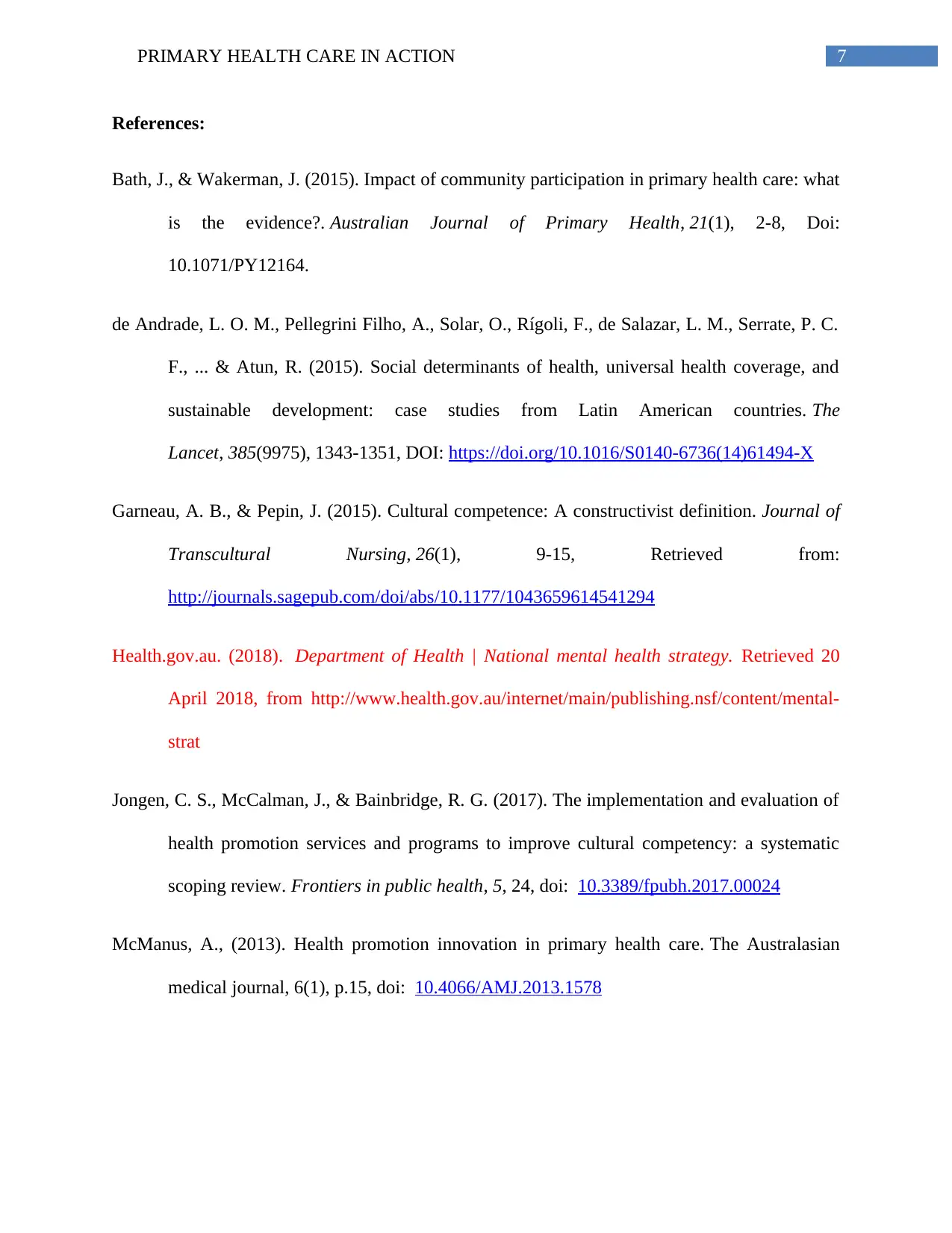
7PRIMARY HEALTH CARE IN ACTION
References:
Bath, J., & Wakerman, J. (2015). Impact of community participation in primary health care: what
is the evidence?. Australian Journal of Primary Health, 21(1), 2-8, Doi:
10.1071/PY12164.
de Andrade, L. O. M., Pellegrini Filho, A., Solar, O., Rígoli, F., de Salazar, L. M., Serrate, P. C.
F., ... & Atun, R. (2015). Social determinants of health, universal health coverage, and
sustainable development: case studies from Latin American countries. The
Lancet, 385(9975), 1343-1351, DOI: https://doi.org/10.1016/S0140-6736(14)61494-X
Garneau, A. B., & Pepin, J. (2015). Cultural competence: A constructivist definition. Journal of
Transcultural Nursing, 26(1), 9-15, Retrieved from:
http://journals.sagepub.com/doi/abs/10.1177/1043659614541294
Health.gov.au. (2018). Department of Health | National mental health strategy. Retrieved 20
April 2018, from http://www.health.gov.au/internet/main/publishing.nsf/content/mental-
strat
Jongen, C. S., McCalman, J., & Bainbridge, R. G. (2017). The implementation and evaluation of
health promotion services and programs to improve cultural competency: a systematic
scoping review. Frontiers in public health, 5, 24, doi: 10.3389/fpubh.2017.00024
McManus, A., (2013). Health promotion innovation in primary health care. The Australasian
medical journal, 6(1), p.15, doi: 10.4066/AMJ.2013.1578
References:
Bath, J., & Wakerman, J. (2015). Impact of community participation in primary health care: what
is the evidence?. Australian Journal of Primary Health, 21(1), 2-8, Doi:
10.1071/PY12164.
de Andrade, L. O. M., Pellegrini Filho, A., Solar, O., Rígoli, F., de Salazar, L. M., Serrate, P. C.
F., ... & Atun, R. (2015). Social determinants of health, universal health coverage, and
sustainable development: case studies from Latin American countries. The
Lancet, 385(9975), 1343-1351, DOI: https://doi.org/10.1016/S0140-6736(14)61494-X
Garneau, A. B., & Pepin, J. (2015). Cultural competence: A constructivist definition. Journal of
Transcultural Nursing, 26(1), 9-15, Retrieved from:
http://journals.sagepub.com/doi/abs/10.1177/1043659614541294
Health.gov.au. (2018). Department of Health | National mental health strategy. Retrieved 20
April 2018, from http://www.health.gov.au/internet/main/publishing.nsf/content/mental-
strat
Jongen, C. S., McCalman, J., & Bainbridge, R. G. (2017). The implementation and evaluation of
health promotion services and programs to improve cultural competency: a systematic
scoping review. Frontiers in public health, 5, 24, doi: 10.3389/fpubh.2017.00024
McManus, A., (2013). Health promotion innovation in primary health care. The Australasian
medical journal, 6(1), p.15, doi: 10.4066/AMJ.2013.1578
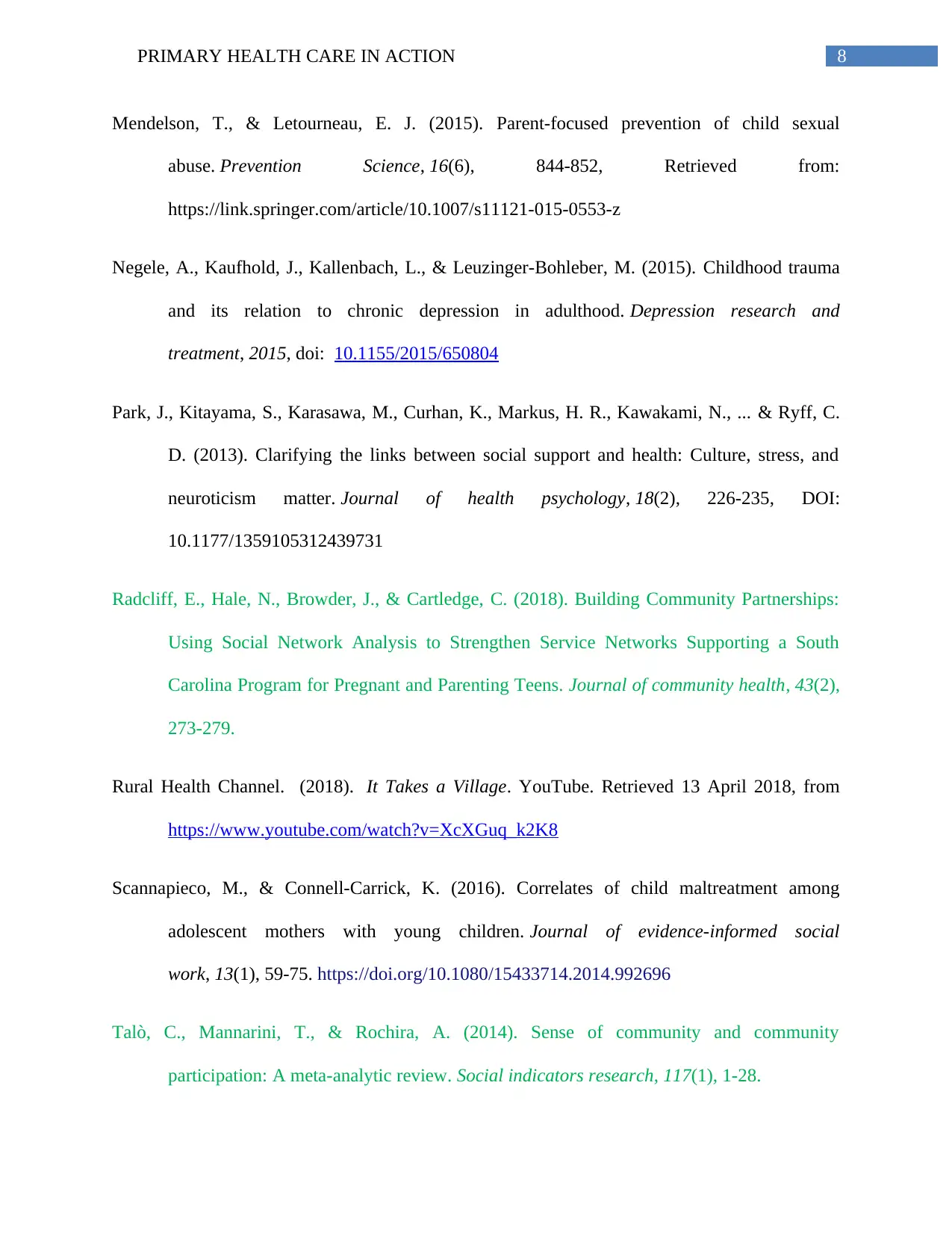
8PRIMARY HEALTH CARE IN ACTION
Mendelson, T., & Letourneau, E. J. (2015). Parent-focused prevention of child sexual
abuse. Prevention Science, 16(6), 844-852, Retrieved from:
https://link.springer.com/article/10.1007/s11121-015-0553-z
Negele, A., Kaufhold, J., Kallenbach, L., & Leuzinger-Bohleber, M. (2015). Childhood trauma
and its relation to chronic depression in adulthood. Depression research and
treatment, 2015, doi: 10.1155/2015/650804
Park, J., Kitayama, S., Karasawa, M., Curhan, K., Markus, H. R., Kawakami, N., ... & Ryff, C.
D. (2013). Clarifying the links between social support and health: Culture, stress, and
neuroticism matter. Journal of health psychology, 18(2), 226-235, DOI:
10.1177/1359105312439731
Radcliff, E., Hale, N., Browder, J., & Cartledge, C. (2018). Building Community Partnerships:
Using Social Network Analysis to Strengthen Service Networks Supporting a South
Carolina Program for Pregnant and Parenting Teens. Journal of community health, 43(2),
273-279.
Rural Health Channel. (2018). It Takes a Village. YouTube. Retrieved 13 April 2018, from
https://www.youtube.com/watch?v=XcXGuq_k2K8
Scannapieco, M., & Connell-Carrick, K. (2016). Correlates of child maltreatment among
adolescent mothers with young children. Journal of evidence-informed social
work, 13(1), 59-75. https://doi.org/10.1080/15433714.2014.992696
Talò, C., Mannarini, T., & Rochira, A. (2014). Sense of community and community
participation: A meta-analytic review. Social indicators research, 117(1), 1-28.
Mendelson, T., & Letourneau, E. J. (2015). Parent-focused prevention of child sexual
abuse. Prevention Science, 16(6), 844-852, Retrieved from:
https://link.springer.com/article/10.1007/s11121-015-0553-z
Negele, A., Kaufhold, J., Kallenbach, L., & Leuzinger-Bohleber, M. (2015). Childhood trauma
and its relation to chronic depression in adulthood. Depression research and
treatment, 2015, doi: 10.1155/2015/650804
Park, J., Kitayama, S., Karasawa, M., Curhan, K., Markus, H. R., Kawakami, N., ... & Ryff, C.
D. (2013). Clarifying the links between social support and health: Culture, stress, and
neuroticism matter. Journal of health psychology, 18(2), 226-235, DOI:
10.1177/1359105312439731
Radcliff, E., Hale, N., Browder, J., & Cartledge, C. (2018). Building Community Partnerships:
Using Social Network Analysis to Strengthen Service Networks Supporting a South
Carolina Program for Pregnant and Parenting Teens. Journal of community health, 43(2),
273-279.
Rural Health Channel. (2018). It Takes a Village. YouTube. Retrieved 13 April 2018, from
https://www.youtube.com/watch?v=XcXGuq_k2K8
Scannapieco, M., & Connell-Carrick, K. (2016). Correlates of child maltreatment among
adolescent mothers with young children. Journal of evidence-informed social
work, 13(1), 59-75. https://doi.org/10.1080/15433714.2014.992696
Talò, C., Mannarini, T., & Rochira, A. (2014). Sense of community and community
participation: A meta-analytic review. Social indicators research, 117(1), 1-28.
⊘ This is a preview!⊘
Do you want full access?
Subscribe today to unlock all pages.

Trusted by 1+ million students worldwide
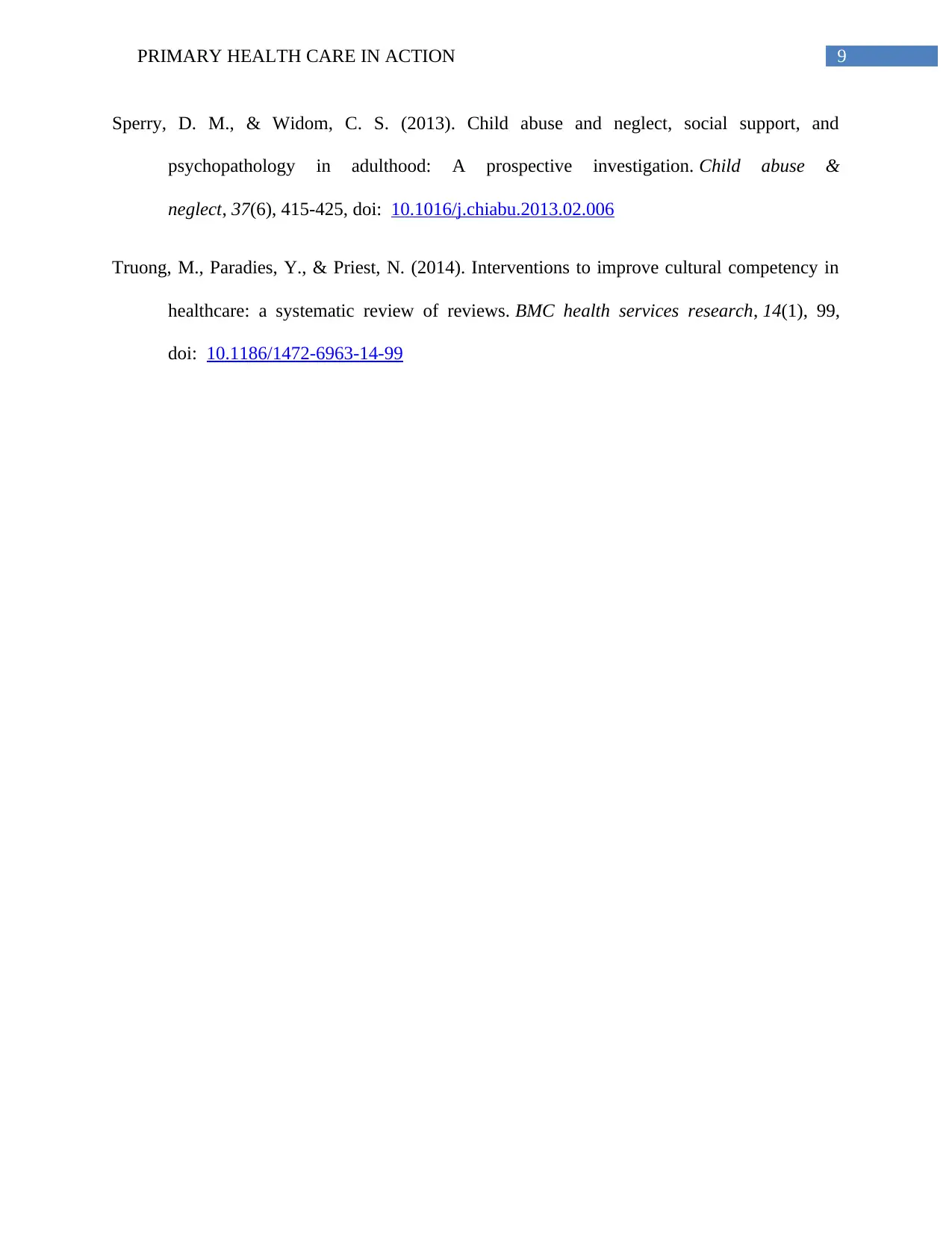
9PRIMARY HEALTH CARE IN ACTION
Sperry, D. M., & Widom, C. S. (2013). Child abuse and neglect, social support, and
psychopathology in adulthood: A prospective investigation. Child abuse &
neglect, 37(6), 415-425, doi: 10.1016/j.chiabu.2013.02.006
Truong, M., Paradies, Y., & Priest, N. (2014). Interventions to improve cultural competency in
healthcare: a systematic review of reviews. BMC health services research, 14(1), 99,
doi: 10.1186/1472-6963-14-99
Sperry, D. M., & Widom, C. S. (2013). Child abuse and neglect, social support, and
psychopathology in adulthood: A prospective investigation. Child abuse &
neglect, 37(6), 415-425, doi: 10.1016/j.chiabu.2013.02.006
Truong, M., Paradies, Y., & Priest, N. (2014). Interventions to improve cultural competency in
healthcare: a systematic review of reviews. BMC health services research, 14(1), 99,
doi: 10.1186/1472-6963-14-99
1 out of 10
Related Documents
Your All-in-One AI-Powered Toolkit for Academic Success.
+13062052269
info@desklib.com
Available 24*7 on WhatsApp / Email
![[object Object]](/_next/static/media/star-bottom.7253800d.svg)
Unlock your academic potential
Copyright © 2020–2025 A2Z Services. All Rights Reserved. Developed and managed by ZUCOL.




